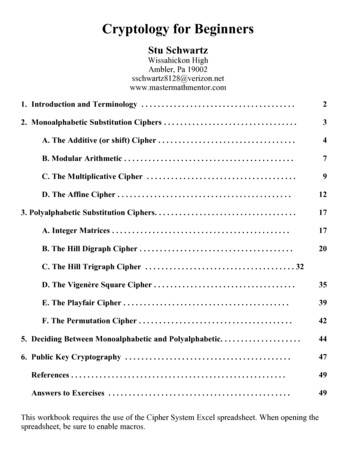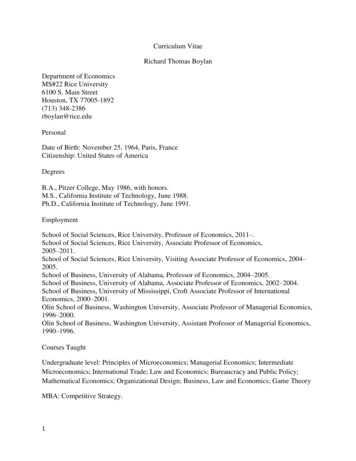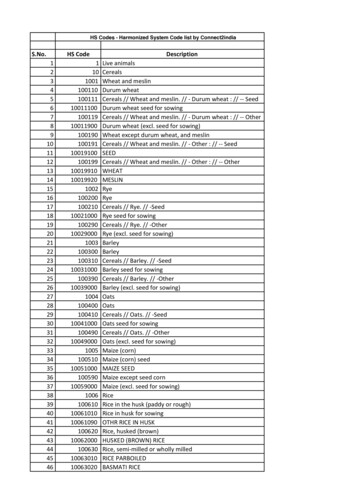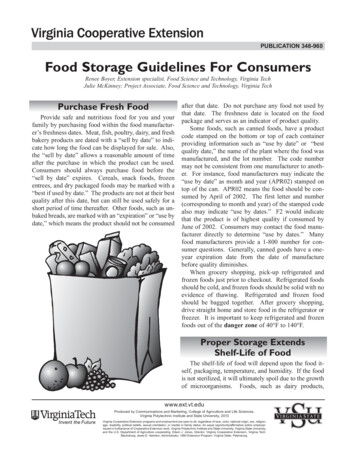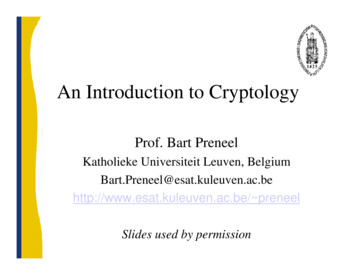
Transcription
An Introduction to CryptologyProf. Bart PreneelKatholieke Universiteit Leuven, esat.kuleuven.ac.be/ preneelSlides used by permission
Comp527 status items Voting machine project is out– Does everybody have a partner? Next three weeks: crash course incryptography and crypto-protocols
Some books on cryptology B. Schneier, Applied Cryptography, Wiley, 1996.Widely popular and very accessible – make sure you getthe errata. D. Stinson, Cryptography: Theory and Practice,CRC Press, 1995. Solid introduction, but only for themathematically inclined. 2nd edition, part 1 available in 2002. A.J. Menezes, P.C. van Oorschot, S.A. Vanstone,Handbook of Applied Cryptography, CRC Press,1997. The bible of modern cryptography. Thorough andcomplete reference work – not suited as a first text book.All chapters can be downloaded for free athttp://www.cacr.math.uwaterloo.ca/hac
More information: some links IACR (International Association forCryptologic Research): www.iacr.org IETF web site: www.ietf.org Cryptography faq:www.faqs.org/faqs/cryptography-faq links: Ron Rivest, David Wagner, Counterpanewww.counterpane.com/hotlist.html Digicrime (www.digicrime.org) - not seriousbut informative and entertaining
Information security: a puzzleNetwork SecurityAudit/logging/intrusion det.Physical SecuritySecurity PolicySecureOperating SystemCryptology/PKILogical securityOrganisationalSecurityPersonnel Security
Process approach to securitypreventionresponsedetection
Data confidentialityEveAliceBob
Entity authenticationHello,I am AliceEveBob
Data authenticationEveAliceBob
Non-repudiation (origin)AliceI neverthis sentmessageBob
Non-repudiation (receipt)Alicereve dnI ive ee sagcersemsithBob
Denial of serviceEveAliceBob
onymityauthenticationdata authenticationidentificationNon-repudiation of origin, receiptContract signingNotarisation and Timestamping
Cryptology: basic principlesEveAliceCleartextCRYPTOBOXBob% C&@& (% C&@& (CRYPTOBOXCleartext
Symmetric cryptology:confidentiality old cipher systems:– transposition, substitution, rotor machines the opponent and her powerthe Vernam schemeA5/1, Bluetooth, RC4DES and triple-DESAES
Old cipher systems (pre-1900) Caesar cipher: shift letters over k positionsin the alphabet (k is the secret key)THIS IS THE CAESAR CIPHERWKLV LV WKH FDHVDU FLSKHU Julius Caesar never changed his key (k 3).
Cryptanalysis PROPSQSPQTRTQRUSURSVTVSTWUWT
Old cipher systems (pre-1900) (2) Substitutions– ABCDEFGHIJKLMNOPQRSTUVWXYZ– MZNJSOAXFQGYKHLUCTDVWBIPER TranspositionsTRANSORI SPOSITNOTITIONSOSANP
Security there are n! different substitutions on analphabet with n letters there are n! different transpositions of n letters n 26:n! 403291461126605635584000000 4 1026keys trying all possibilities at 1 nanosecond per keyrequires.
Easy tobreak simplesubsitutionusing12statisticaltechniques 10Letter distributions86420A B C D E F G HI Y Z
Assumptions on Eve (the opponent) Cryptology cryptography cryptanalysis Eve knows the algorithm, except for the key(Kerckhoffs’s principle) increasing capability of Eve:– knows some information about the plaintxt (e.g., inEnglish)– knows part of the plaintext– can choose (part of) the plaintext and look at the ciphertext– can choose (part of) the ciphertext and look at the plaintext
Assumptions on Eve (the opponent) A scheme is broken if Eve can deduce the keyor obtain additional plaintext Eve can always try all possible keys till“meaningful” plaintext appears:a brute force attack– solution: large key space Eve will try to find shortcut attacks (fasterthan brute force)– history shows that designers are too optimisticabout the security of their cryptosystems
New assumptions on Eve Eve may have access to side channels–––––timing attackssimple power analysisdifferential power analysisdifferential fault analysiselectromagnetic interference
Side channel analysisOscilloscopefiles transferArm scoperetrieve fileScope triggeron IOCurrent waveformacquisitionServerMain PCstore the filesrun the Acquisitionand run the TreatmentsoftwaresoftwareRGCRCard extentioncommand emissionCardreaderProtection box
Timing attacks and power analysis
Cryptology side channelsEveAliceCleartextBobCRYPTOBOX% C&@& (% C&@& (CRYPTOBOXCleartext
The Rotor machines (WW II)
Life cycle of a cryptographic algorithmideamathematical analysispublicationpublic evaluationRIPOKhw/sw implementationstandardizationindustrial products take out of service
Vernam scheme (1917) Shannon (1948) key is random string, as long as the plaintextP10010K01011 C1100111001K01011 P10010
Vernam scheme perfect secrecy: ciphertext gives opponentno additional information on the plaintextor H(P C) H(P) impractical: key is as long as the plaintext but this is optimal: for perfect secrecyH(K) H(P)
Three approaches in cryptography information theoretic security– ciphertext only– part of ciphertext only– noisy version of ciphertext system-based or practical security– also known as “prayer theoretic” security complexity theoretic security:model of computation, definition, proof– variant: quantum cryptography
Design of ciphers More on this in a week (Sept. 11 / 16) For now, the high-level details– Symmetric key cryptography Stream ciphersBlock ciphersMessage authentication codes (MACs)Hash functions– Public key cryptography Encryption Digital signatures
Model of a practical noutputfunctionoutputfunctionCP
Example stream ciphers Bluetooth A5 (used in GSM cel phones) RC4 (used by most SSL web sites) Generally faster than block ciphers– Often less secure– If you ever reuse a key, the system collapses
Block 3 larger data units: 64 128 bits memoryless repeat simple operation (round) many times
Example block ciphers DES (56-bit), Triple-DES (168-bit) AES / Rijndael (several key lengths) Many, many others Generally slower Very versatile: can make stream ciphers,hash functions, many other uses
How NOT to use a block cipher:ECB modeP1P2P3blockcipherblockcipherblockcipherC1C2C3
How to use a block cipher: CBC modeP1P2P3AESAESAESC1C2C3IVneed random IV
An example plaintext
Encrypted with AES in ECBmode
Encrypted with AES in CBCmode
Symmetric cryptology:data authentication the problem hash functions without a key– MDC: Manipulation Detection Codes hash functions with a secret key– MAC: Message Authentication Codes
Data authentication: the problem encryption provides confidentiality:– prevents Eve from learning information on thecleartext/plaintext– but does not protect against modifications (activeeavesdropping) Bob wants to know:– the source of the information (data origin)– that the information has not been modified– (optionally) timeliness and sequence data authentication is typically more complexthan data confidentiality
Data authentication: MDC MDC (manipulationdetection code) Protect short hash valuerather than long textThis is an input to acryptographic hash function. Theinput is a very long string, that isreduced by the hash function to astring of fixed length. There areadditional security conditions: itshould be very hard to find aninput hashing to a given value (apreimage) or to find two collidinginputs (a collision). (MD5)SHA-1SHA-256, -512RIPEMD-1601A3FD4128A198FB3CA345932
Data authentication: MAC Replace protection of authentictyof (long) message by protectionof secrecy of (short) key Add MAC to the plaintextThis is an input to a MACalgorithm. The input is a verylong string, that is reduced by thehash function to a string of fixedlength. There are additionalsecurity conditions: it should bevery hard for someone who doesnot know the secret key tocompute the hash function on anew input. CBC-MAC HMAC7E6FD7198A198FB3C
MAC rtext
cryptography and crypto-protocols. Some books on cryptology B. Schneier, Applied Cryptography, Wiley, 1996. . Handbook of Applied Cryptography, CRC Press, 1997. The bible of modern cryptography. Thorough and complete reference work - not suited as a first text book.
